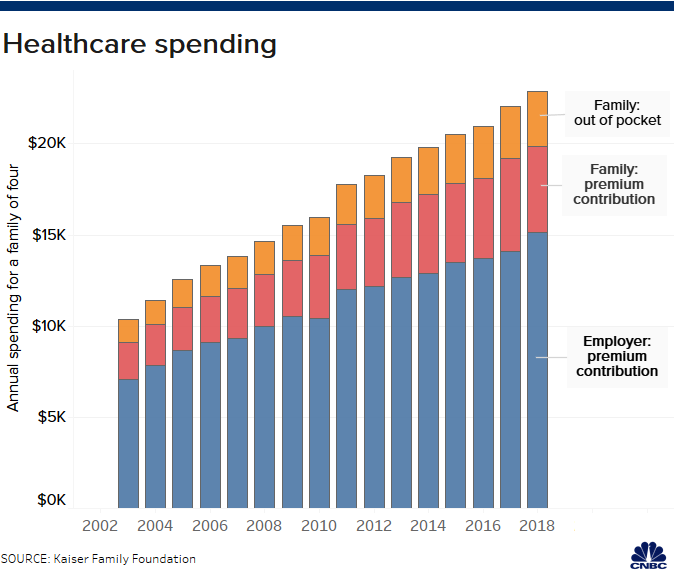The state of health insurance in the United States and in California, in particular, is always shifting and evolving. While this is true, there are some trends that have stayed constant for most of the last 20 years is the inexorable rise in monthly health insurance premiums. This has been especially marked since 2009.
In 2020 this trend will be no less significant. The federal government estimates an increase of approximately five percent over the average monthly costs just five years ago.
Here is a chart from CNBC’s website illustrating this ongoing trend:
CNBC also noted the following points:
- Average total health spending for a family of four with workplace coverage hit $7,726 in 2018, a 67% increase from 10 years ago, according to the Kaiser Family Foundation.
- Expenses have also gone up for employers, who spent an average of $15,159 in premiums to cover a family of four.
- Medical coverage costs have outpaced wage growth: Families’ costs are up 67% compared to a decade ago, while wages have increased 26%, according to the foundation.
Along with this not-so-great outlook is another negative trend, and that’s the seemingly increase in shortage of doctors.
Why Can’t I Find a Doctor?
A somewhat disturbing development that will become even more impactful going into 2020 is the lack of doctors, specialists and other skilled medical personnel. Although actual numbers are hard to pin down as this is a largely dynamic situation, anecdotal evidence is becoming increasingly common.
One family in Sonoma County, for example, enrolled with a new health insurance provider after the husband changed jobs. They chose a specific health care institution since this was this network they had been part of previously.
However, their preferred care provider (PCP) had unexpectedly moved on after having been their doctor for less than a month. He was the second doctor they had been assigned by their health care provider after their long-time doctor had retired a year earlier. Now they needed to find a new doctor.
After checking with six different campuses throughout the county, they finally succeeded in securing the services of a PCP in a town 15 miles away. However, this doctor was already booked out three months so their “new patient” visit would have to wait.
An article in the Los Angeles times reports that,
“California will be short about 4,100 primary-care doctors by 2030, according to a recent report from the California Future Health Workforce Commission, a blue-ribbon panel co-chaired by University of California President Janet Napolitano and Lloyd Dean, chief executive of Dignity Health.”
This is creating serious issues for hospitals, patients and remaining doctors and nurse practitioners. The reasons for this increasing shortage are numerous. According to a post at CalMatters.org,
“California is facing a growing shortage of primary care physicians, one that is already afflicting rural areas and low-income inner city areas, and is forecasted to impact millions of people within ten years. Not enough newly minted doctors are going into primary care, and a third of the doctors in the state are over 55 and looking to retire soon, according to a study by the Healthforce Center at UC-San Francisco.”
Low acquisition of new doctors and high attrition through retirement makes for distressing numbers when it comes to providing good health care.
The same article goes on to state that, “That means by 2030, the state… could be down by as many as 10,000 primary care clinicians, including nurse practitioners and physician assistants.” Regions such as the Central Valley, Central Coast and Southern Border region, as well as most rural areas will be hit especially hard.
A Positive Trend for Health Insurance in 2024
Technology has always played a vital role in healthcare and in the health insurance industry, as well. Today, outlier technologies promise to take up a more prominent role in the very near future.
According to a blog post at HealthAffairs.org,
“In the consumer markets, technology companies have started dipping their toes into the waters — to manage the flow of health care information in the case of the Apple Health Records platform, to connect patients to providers in the case of Uber and Lyft, and to bring the Prime buying experience to consumer medical products in the case of Amazon buying PillPack and selling common durable medical equipment through its online marketplace.”
Along with these developments, artificial intelligence, or AI, is being implemented in a widening scope of physician-led functions, according to the post, with the goal of streamlining and improving the overall tasks, and “to guide attending physicians toward evidence-based care decisions, alert them to data and research they may not have seen, or catch potential safety issues, such as duplicative treatments or medication interactions.”
WorkWith Health Insurance Professionals to Stay on Top of the Trends
J.C. Lewis Insurance Services is a family-owned and operated California health insurance agency licensed to do business in California. We specialize in medical insurance plans for Small Businesses, Individual and Families, and people with Medicare. At J.C. Lewis Insurance, our agents are licensed by the state of California and are certified to sell policies through Covered California. In addition, we offer accountability, explanations, and over 60 years of experience in the insurance industry. Contact us today at 866-745-9555 or fill out our online contact form.
Navigating Health Insurance Trends and Challenges in California
The Rising Cost of Health Insurance
The persistent climb in health insurance premiums shows no signs of slowing. Since 2009, monthly costs have consistently increased, and federal estimates suggest a 5% hike compared to averages five years ago. This financial burden weighs heavily on families and employers alike. According to the Kaiser Family Foundation, average health spending for a family of four with workplace coverage reached $7,726 in 2018, a staggering 67% increase over a decade. Meanwhile, employer premiums surged to $15,159, outpacing wage growth, which rose only 26% during the same period.
The Growing Doctor Shortage
One of the most pressing issues is the dwindling number of healthcare providers, especially primary care doctors. California faces a projected shortage of 4,100 primary-care physicians by 2030, as reported by the California Future Health Workforce Commission. The problem is exacerbated by low interest in primary care among new medical graduates and a significant portion of current doctors nearing retirement age. Areas like the Central Valley and rural regions are particularly vulnerable, with patients facing months-long waits to secure care.
Technology: A Beacon of Hope
Amid these challenges, technological advancements offer potential solutions. Companies like Apple, Amazon, Uber, and Lyft are revolutionizing healthcare access and delivery. For example, Apple’s Health Records platform centralizes patient information, while Amazon’s PillPack streamlines medication access. Artificial intelligence is also enhancing medical decision-making by providing evidence-based recommendations and reducing errors like duplicate treatments.
California’s Medicaid Expansion in 2025: What You Need to Know
Here’s something big that isn’t getting enough buzz—California’s Medi-Cal program just expanded again in 2025. Now, all low-income adults regardless of immigration status can qualify for full-scope Medi-Cal benefits, including dental, vision, and mental health services. This is a game-changer for undocumented residents who were previously stuck with emergency-only coverage. If your household income is at or below 138% of the federal poverty level (about $20,783/year for an individual), you’re likely eligible. What’s more, the application process is way simpler now thanks to CalHEERS streamlining their digital enrollment system. If you’ve been avoiding health insurance because you thought you wouldn’t qualify—2025 might be your year.
The Digital Divide in Health Access: Are You Being Left Behind?
With all this talk about telehealth, AI, and health apps, one thing that’s often overlooked is digital health literacy. Just because tech is available doesn’t mean everyone can use it. A 2024 study by the California Health Care Foundation found that nearly 1 in 4 adults over age 50 in California struggle with using basic digital health tools—like accessing medical records online or booking a telehealth appointment. That’s a problem, especially for seniors in rural areas or folks who don’t speak English as a first language. If you’re not comfortable with tech, health navigators and community clinics now offer one-on-one digital training—some even come with bilingual support and device lending programs. Definitely something worth checking out if you’ve felt left behind.
Telehealth Parity Laws Are Changing the Game in California
Back in the early days of telehealth, virtual visits were more of a backup plan. But in 2025, California’s new telehealth parity laws require insurers to cover telehealth at the same rate as in-person visits. This means your video doctor appointment is no longer the “cheap version” of care—it’s just care. That’s great news if you’re juggling a packed schedule, live in a rural area, or simply prefer the convenience of home visits. Providers are even integrating remote diagnostic tools like at-home stethoscopes and blood pressure monitors, mailed to you as part of your care plan. So, if you’ve been holding off on scheduling that visit—virtual or not—it’s time to dive in.
Partnering with Health Insurance Experts
To navigate these trends effectively, it’s essential to work with experienced health insurance professionals. J.C. Lewis Insurance Services, a family-owned California health insurance agency, brings over 60 years of expertise. Whether you’re seeking individual, family, or Medicare plans, their licensed agents offer personalized advice and comprehensive support, ensuring you stay informed and covered in this dynamic healthcare landscape.
By staying proactive and informed, you can better manage rising costs and access quality care despite the evolving challenges.





